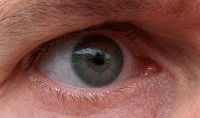Lid closing reflex
The eyelid closing reflex (also orbicularis oculi reflex , corneal reflex , blink reflex ) is a reflective protective mechanism of the eye . It is usually triggered by mechanical effects on the cornea and the immediate area around the eye and manifests itself in the rapid closing of the eyelids . It serves to protect against foreign bodies , against drying out and against damage to the eyeball . Involuntary eyelid closure also occurs with strong light irritation to the eye, with spontaneous acoustic stimuli, and as a result of a startle stimulus .
Neurophysiology
The blink reflex is a so-called external reflex . The afferent (for brain extending) leg of the reflex arc proceeds at tactile stimuli via the ophthalmic nerve , a branch of the fifth cranial nerves ( the trigeminal nerve ), in optical stimuli (flash light) via the optic nerve . After switching over in the trigeminal complex, it conducts the excitation via the superior colliculus or the ruber nucleus to the reticular formation , and only from there to the reflex center in the brain stem , the facial nucleus . A small part of the afferents also reaches this core directly. From there , a contraction of the orbicularis oculi muscle is triggered via the efferent thigh, the facial nerve (cranial nerve VII) . The reflex takes place within about 250 ms, but between 10% and 20% of all test persons do not react to light stimuli with a blink reflex. Acoustic stimuli can also trigger reflective eyelid closure.
Like the pupillary reflex, the eyelid-closing reflex is a consensual reflex; that is, the afferents are directed to both premotor areas. Even when the eye is not irritated, the eyelid closes (in the case of the pupillary reflex, the other eye also narrows when irradiated on one side).
Blink reflex time
The Federal Institute for Occupational Safety and Health found that under typical laser class 2 conditions, only 17% of the test subjects reacted with an eyelid-closing reflex and that this reflex is by no means sufficient as the only protective mechanism for exposure to laser radiation of this class. In the BGI (Berufsgenossenschaftliche Information) 832 “Operation of laser equipment” from April 2003 it says: “As a rule, the presence of the eyelid-closing reflex to protect the eyes must not be assumed. Therefore, if class 2 laser radiation hits your eye, you should consciously close your eyes or turn away immediately ”. The blink reflex time depends on numerous factors, including a. on the size of the light spot on the retina . The accident prevention regulation (UVV) "Laser Radiation" BGV B 2, however, still assumes a blink reflex after 250 ms and thus stands in the way of new research findings.
Influences on eyelid closure

The reflex no longer occurs when both the afferent and the efferent limb fail. In the case of local anesthesia on the eye, it is an indication of its effectiveness. It can also be used as a criterion for assessing the depth of anesthesia . In the case of facial paralysis , the reflex is also absent, but the so-called Bell phenomenon is not absent , which is characterized by an upward lifting of the eyeball with the sclera becoming visible when trying to close the eyes.
In paralytic lagophthalmos , paralysis of the eyelid muscles leads to the inability of the eyelid to close completely. The eyelid closes permanently (e.g. in the case of blindness ) or briefly (e.g. when exposed to the influence of irritants such as capsaicin ).
An induced lid closure also triggers two different phenomena:
- the Bell's phenomenon , which manifests itself in the involuntary movement of both eyeballs upwardly and outwardly, a position which they assume during sleep
- the Westphal-Piltz phenomenon , which is expressed in a narrowing of the pupil size .
Contact lens wearers
It is only possible to insert contact lenses into the eye without holding the eyelid because of the fact that the eyelid closure reflex is an external reflex (and not an intrinsic reflex ). Contact lens wearers get used to this reflex and can then touch the cornea directly.
Reflex control during slaughter
The brain death of slaughtered animals after bleeding is controlled via the blink reflex during slaughter .
See also
Individual evidence
- ↑ a b So that nothing gets in the eye ... Protection against laser radiation http://www.baua.de/cae/servlet/contentblob/675474/publicationFile/47205/A37.pdf Publication of the Federal Institute for Occupational Safety and Health, 2nd revised Edition, December 2010, ISBN 978-3-88261-678-1 . Last accessed on March 2, 2015.
- ↑ Jürgen Wendler, Wolfgang Seidner, Ulrich Eysholdt: Textbook of Phoniatry and Pedaudiology . 4th edition. Thieme-Verlag, Stuttgart 2005, ISBN 3-13-102294-9 .
- ↑ Animal welfare during slaughter: controlled bleeding. On: toennies.de , last accessed on December 15, 2019.
- ↑ Johanna Fischer: Improvement of animal welfare in pig slaughter through a newly developed, automatic bleeding control system. Dissertation, Faculty of Veterinary Medicine, University of Leipzig, Leipzig 2015.

